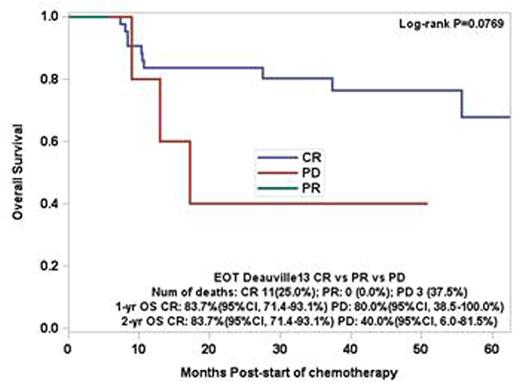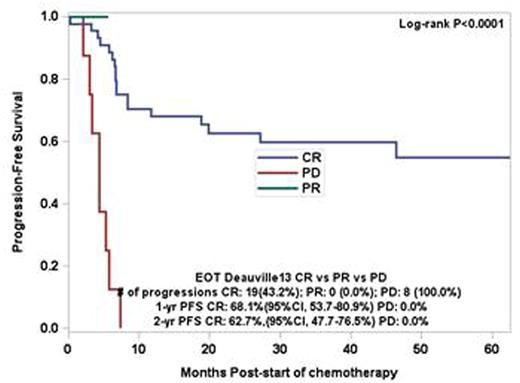Abstract
Introduction: Cure rate of Mature T/NK cell lymphoma (TCL) is rather low and multiple trials are being conducted to improve frontline therapy outcomes. Consolidation with autologous stem cell transplant is becoming widely used as a mean of improving survival (SCT). Based on data from several retrospective trials, pts who achieve CR may not benefit from consolidative SCT. There is no data available on the role of PET-CR as defined by using Deauville criteria (which became standard in response assessment of NHL (The Lugano Classification 2014)). We performed retrospective analysis of 59 pts with TCL examining the correlation between PFS/OS and iPET and eotPET.
Methods: 59 pts newly diagnosed pts with TCL treated between 2008-2016 for whom interim and eotPET scan were available. It was our routine practice to obtain baseline, interim (after 3 cycles of chemotherapy) and eotPET. Pathology slides of outside cases were centrally evaluated by a hematopathologist to confirm diagnosis. Baseline, interim and eotPET were centrally reviewed by a nuclear medicine radiologist blinded to clinical outcomes who assigned Deauville score (DS) to every PET. Responses were recorded according to the Lugano classification 2014. Descriptive statistics and Kaplan Meier method was used to calculate the Progression-free survival (PFS) and Overall survival (OS), two-sided Log-rank test was used to compare OS and PFS between PET groups.
Results: Detailed demographic is presented in Table1. Median age at diagnosis is 59, sixty two percent males, 37% female; ALCL 34%, PTCLnos 22%, AITL 19%, and ATLL 10%; most of pts were advanced stage. Most common chemotherapy regimens used were CHOP/CHOEP, HCVAD, and CODOX, SMILE.
Median follow up time for the entire cohort was 22.7mo. Forty nine percent of pts progressed and 29% of pts died during follow up. Cause of death for majority of pts was disease progression. Following Deauville scores were assigned on iPET and eotPET respectively: DS1 in 37% and 39%, DS2 in 30% and 35%, DS3 in 15% and 6%, DS4 in 9% and 4%, DS5 in 9% and 16%. We analyzed mPFS and mOS for PET-CR using DS1-2 or DS1-3 to define it. Sixty seven percent and 82% were considered in PET-CR on iPET based on DS 1-2 and DS 1-3 respectively. PET-CR went up to 77% and 83% respectively on eotPET.
For final analysis, DS1-2 was used to define PET-CR as no statistically significant difference in mPFS and mOS was noted between DS1-2 and DS1-3. With median follow up of 22.7mo, two-year mPFS and mOS for the cohort were 50% and 74% respectively. Two- year mPFS for iPET-CR and eotPET-CR were 62%. Two-year mOS for iPET-CR and eotPET-CR were 86%% and 83%. Two-year mPFS for iPET-PR and eotPET-PR were 37% and 67%. Two-year mOS for iPET-PR and eotPET-PR were 70% and 100 % (not statistically significant difference with PET-CR mPFS and mOS). None of the pts with PD on iPET were alive at two year. Two-year mOS for eotPET-SD and eotPET-PD are 40%. Negative predictive value of iPET and eotPET is 61%, positive predictive value is 65% and 72% respectively.
Conclusion: While PET-SD and PD is quite predictive of poor survivorship, significant number of PET-CR pts will relapse. Even though PET-CR rate to frontline therapy is high, it does not translate into durable responses for significant number of pts with TCL. Thus, PET-CR is not a sensitive enough measure to be considered as a predictor of long-term remission in TCL. It is important to develop response assessment tools which will correlate better with long term survivorship of TCL patients.
Feldman:Pharmacyclics: Speakers Bureau; Celgene: Speakers Bureau; Seattle Genetics: Consultancy, Speakers Bureau; Abbvie: Consultancy, Speakers Bureau. Leslie:Seattle Genetics: Speakers Bureau; Celgene: Speakers Bureau. Skarbnik:Pharmacyclics: Consultancy, Speakers Bureau; Genentech: Consultancy, Speakers Bureau; Abbvie: Consultancy, Speakers Bureau. Mato:Theradex: Research Funding; TG Therapeutics: Research Funding; ProNAi: Research Funding; Gilead Sciences: Research Funding; Acerta Pharma: Research Funding; Abbvie: Research Funding; TG Therapeutics: Consultancy; Pharmacyclics: Consultancy; Gilead Sciences: Consultancy; Abbvie: Consultancy. Chow:Seattle Genetics: Speakers Bureau. Protomastro:COTA: Employment. Leslie:Celgene: Speakers Bureau; Seattle Genetics: Speakers Bureau. Goy:Acerta: Consultancy, Honoraria, Membership on an entity's Board of Directors or advisory committees; Celgene: Consultancy, Honoraria, Membership on an entity's Board of Directors or advisory committees, Research Funding; Takeda: Consultancy, Honoraria, Membership on an entity's Board of Directors or advisory committees, Other: Writing support, Speakers Bureau; Pharmacyclics: Consultancy, Honoraria, Membership on an entity's Board of Directors or advisory committees, Research Funding, Speakers Bureau; Genentech: Research Funding; Infinity: Consultancy, Membership on an entity's Board of Directors or advisory committees; Janssen: Consultancy, Honoraria, Research Funding, Speakers Bureau.
Author notes
Asterisk with author names denotes non-ASH members.




This feature is available to Subscribers Only
Sign In or Create an Account Close Modal